
Station Name: SALVATION ARMY HALT

The Salvation
Army's printing works, siding and loading dock c1910. The photo is taken from the Sanders' Orchard Nurseries platform which was out of use by this time having been replaced by Salvation Army Halt on the west side of Camp Road.
Photo from John Mann collection 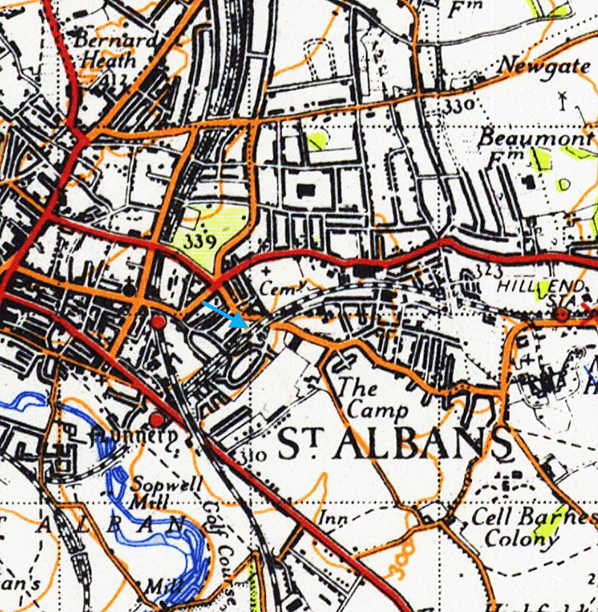 
1880 1:2,500 OS map shows the Camp Road site before the arrival of Sander's orchid nurseries and the printing works
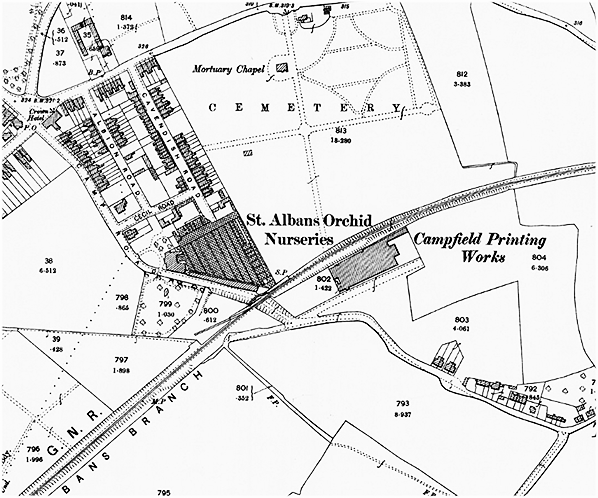
1897 1:2,500 OS map. Shows the Campfield Printing Works before it was taken over by the Salvation Army in 1901. The print works siding hasn't yet been laid although the low embankment has been widened to accommodate a siding, The St Albans Orchid Nurseries have now been built and a siding on the west side of Camp Road has been laid. There has been some residential development to the north of the Orchid nurseries.
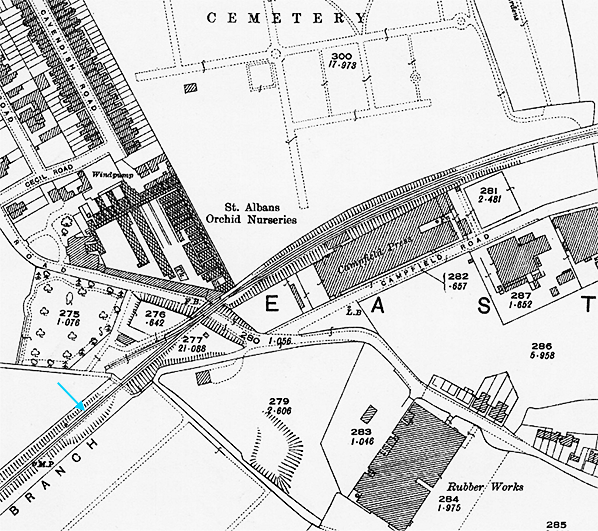 1927 1:2,500 OS map. The Campfield Printing Works has been extended with a new Campfield Road running to the south of the main building. Salvation Army Halt is not named but the platform is shown (indicated by blue arrow). The St Albans Orchid Nurseries have expanded with a new footbridge (FB) across Camp Road linking the works with the siding.
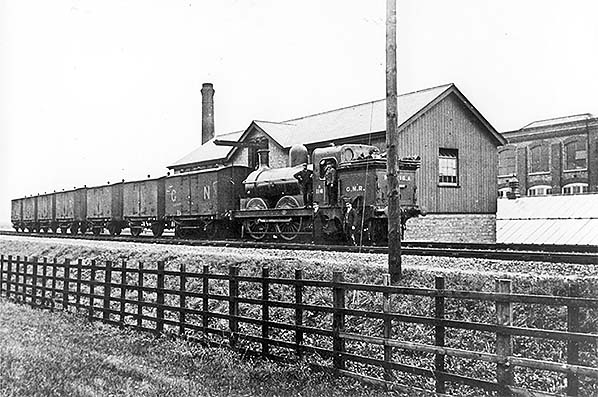
A goods train and staff pose for the camera on the Salvation Army Print Works siding sometime between 1905 and 1918. The Hatfield - St Albans branch runs this side of the train. The third van of the train is uncoupled, suggesting posing for the camera was done in the midst of a shunting operation. The locomotive is a member of Patrick Stirling's 126 Class, of which thirteen were built at Doncaster commencing in 1868 for suburban work to and from the Widened Lines. The locomotives were an 0-4-2WT (Well Tank) design, this necessitating a lengthy gap of thirteen feet between the rearmost driving axle and the trailing axle; the men standing beside the locomotive hiding from view the peculiar appearance which resulted. The class originally had domeless boilers of the typical Stirling design and very rudimentary cabs. They were given slightly larger boilers, but still domeless, in the 1880s and when H.A. Ivatt, father of H.G. Ivatt, succeeded Stirling as Locomotive Superintendent of the GNR he modified five members of the 126 Class further, this time with domed boilers, which modification also resulted in the somewhat uneasy-looking cab design. No.A116, seen here, was one of the five so-modified locomotives and in this form became Great Northern Railway Class F6, while the domeless examples became Class F4. Note that the number is given as "A116" on the cabside but as "116. A" on the rear of the bunker. The addition of the "A" signified locomotives placed on the Duplicate List. In this case it was to make way for Ivatt's ponderous and not entirely successful L1 Class 0-8-2T's, later to become LNER Class R1. Withdrawals of what began life as the 126 Class began in 1905 and the entire class became extinct in 1918.
Photo from John Mann collection 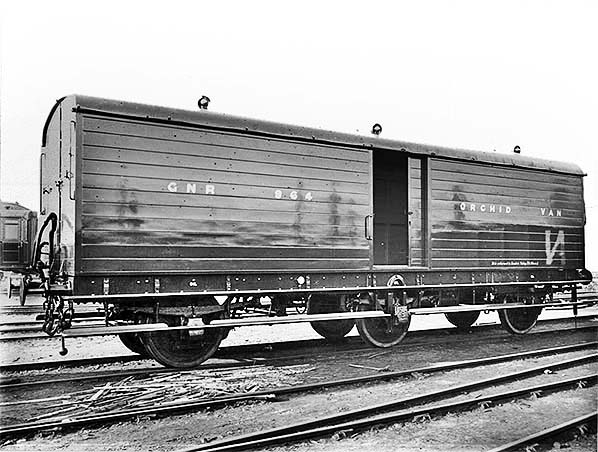 Orchid Van Great Northern Railway No.964 poses for the camera at an unknown location. Note the clerestory carriage just visible at extreme left which shows signs of being an East Coast Joint Stock vehicle. The suggests the location is somewhere on the Great Northern main line. The reversed 'N' on the right is a reflection from an adjacent GN open wagon, this blemish alone tells us this is not an official railway photograph despite the van, or at least its body, being new. The van, believed to have been one of two, is passenger rated (meaning it can be attached to passenger trains), has screw couplings and is apparently dual braked. There are three lubrication points on the solebar, one above each axlebox, and same would have been present on the other side. The six wheel underframe is fitted with safety chains, normal for the time, and runs on Mansell wheels. The underframe possibly began life underneath a passenger carriage of some description. The wording on the lower bodyside, right, states 'To be returned to Sander's siding' followed by two other words which are unreadable but likely say 'St Albans'.
Copyright photo from National Railway Museum reproduced under creative commons licence. 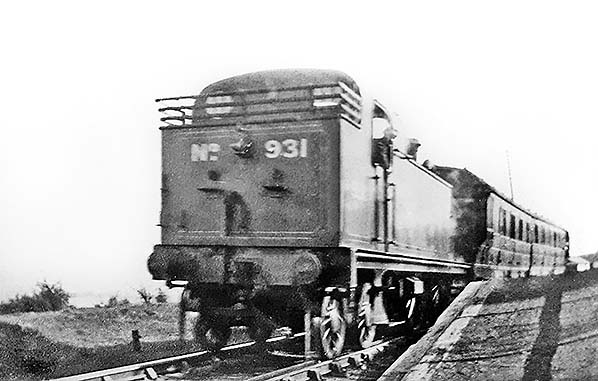
No.931 was a GNR Stirling 766 Class 0-4-4T, built Doncaster 1892. They were fitted with condensing equipment for working down to Moorgate and you can just see the steam pipe above the water tank, to the right of the chimney. The 29 - strong class was removed from London area service in 1907 and transferred out of the area, condensing equipment removed, so the photo will be pre-1907. Some survived to become Class G1 under the LNER but all had been withdrawn by 1927. No.931 was not among those to see LNER service but its withdrawal date is not known. Photo from Jim Lake collection halt_old7.jpg) The Salvation
Army's printing works, siding and loading dock in 1928. St Albans Orchid Nurseries are seen top left, the original Sanders' platform was sited immediately east of the Camp Road bridge seen on the left. Click here for a larger version.
Photo from Britain From Above, reproduced with permission halt_old5.jpg)
A passing passenger train is seen at Salvation Army Halt c1950. Sander's siding can just be made out beyond the platform.
Photo from John Mann collection halt_old8.jpg) N7/1 69637 is seen at Salvation Army Halt in August 1955 following a derailment The loco and 25 wagons derailed at 15 mph following vandalism at Camp Road. Nobody was hurt and the loco received little damage and remained in service until withdrawal from Hornsey shed in March 1959.
Photo from Jim Lake collection halt_old6.jpg) old1.jpg)
Salvation Army Halt looking east towards Hatfield in March 1961. A public footpath across the track is seen beyond the platform.
Photo by David Pearson old2.jpg) Eastern Region Diesel shunter D3709, with a brake van in tow, passes Salvation Army Halt on 24 April 1965, heading towards Hatfield. The bridge carrying the Midland Main Line over the G N R branch is seen in the background.
Photo by David Pearson army_halt3.jpg)
Salvation Army Halt looking west towards St. Albans c1966.
Photo
from John Mann collection
army_halt4.jpg) Salvation Army Halt looking east towards Hatfield c1966. The public footpath across the track has now been fenced. Salvation Army Halt looking east towards Hatfield c1966. The public footpath across the track has now been fenced.Photo from John Mann collection army_halt5.jpg) army_halt6.jpg)
Looking east at Salvation Army Halt in February 1986. The track bed is completely overgrown and the platform hidden by undergrowth. Although the Alban Way footpath and cycleway opened in 1985, clearance of the track bed clearly hasn't yet reach St. Albans.
Photo by John Mann  By April 2004 the Alban Way footpath and cycleway had been established for nearly 20 years. Although a little overgrown the halt is clearly visible in this view looking west.
Photo by Nick Pedley 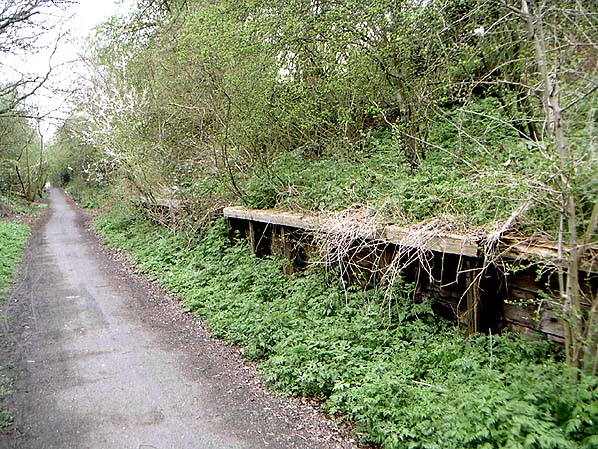
Salvation
Army Halt looking west in April.2004
Photo by Nick Pedley 
The platform remains overgrown alongside the Alban Way footpath but a new sign identifies the location . It is not intended to suggest that the halt ever had a name board. There is also an interpretation panel nearby with photographs and a history of the site.
Photo by Isaac Kenyon [Source:
Nick Catford]
 Home Page Home Page
|
